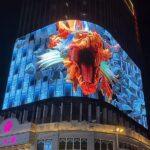LED Screen Sizes: Finding the Perfect Size for Your Needs
Did you know that choosing the wrong LED Screen size may lead to 30% budget waste? According to Grand View Research data, the global LED display market size will reach US$10.7 billion in 2025, but 23% of the projects are forced to rework due to size issues (AVIXA 2023 report).
As a LED screen supplier with 10 years of experience, we have witnessed a billboard in Times Square, New York, cost $180K more than it should have been because it was too large, and a digital signage in a retail store in Tokyo was ignored by customers because it was too small.
This article will use practical experience and scientific formulas to help you accurately match your needs and avoid costly mistakes.
1. LED Screens Size: An Underestimated Business Decision
Size directly affects visual quality, cost, and ROI:
Too small: The shopping mall’s digital signage initially used a 6-square-meter screen, which failed to attract traffic from the atrium and saw a 37% drop in click-through rate (this was resolved by replacing it with a 12-square-meter screen).
Too big: A music festival used 200 square meters of LED walls, which exceeded actual needs, causing electricity and installation costs to soar by 42%.
Industry truth: Optimizing the size can increase audience retention time by 65% and increase ad conversion rate by 28% (Digital Signage Today)
2. Standard LED Screen Size Comparison Table
Mainstream LED displays are classified by Pixel Pitch:
Pixel pitch | Typical size | Best application scenario
P1.2-P2.5: 2m×3m to 10m×6m: luxury store custom led display
P2.5-P4: 3m×5m to 15m×8m: corporate exhibition hall led walls
P4-P6: 5m×8m to 20m×12m: stadium LED display device
P8: 10m×20m : highway advertising screen
The P4 customized LED display (32m×9m) in a certain Marina Bay perfectly fits the curved building and has become an Instagram check-in hotspot, with an average daily exposure of over 500,000 times.
3. 5 factors determine your LED Displays size
1. Resolution and content type
Playing 8K video requires ≤P2.5, while text-based digital signage can use P6 to reduce costs.
A theater uses P1.8 LED screen to achieve naked-eye 3D stage effects, and the ticket sell-out rate has increased by 41%.
2. Pixel pitch and viewing distance
Golden formula: Minimum viewing distance (meters) = pixel pitch (mm) × 2.5
(Example: The closest viewing distance of a P4 screen is 6 to 9 meters)
The P5 LED display device at a certain airport clearly displays flight information 40 meters away, reducing the missed flight rate by 19%.
3. Project Budget
4. Installation environment (outdoor vs. indoor)
The size of outdoor screens needs to be increased by 10%-15% to offset sunlight reflection (for example, the P6 screen on the Bund in Shanghai is 12% larger than the original design).
The load-bearing capacity of indoor LED walls needs to be considered: the P2.5 screen weighs 35kg per square meter, and the building structure needs to be reinforced in advance.
5. Customized requirements
The cost of special-shaped custom LED displays (such as ring-shaped and wavy) increases by 15%-30%, but the brand recognition increases by 200%
4. Four steps to lock the perfect led led wall size
1. Clarify the core goal: brand exposure? information delivery? immersive experience?
2. Measure the installation area: length × width × height, and reserve 20% of the heat dissipation space.
3. Calculate pixel density: Use an LED size calculator (ask for one from LED screen suppliers).
4. Simulation verification: Suppliers are required to provide 3D rendering of field prototypes for testing.
Avoid using standard sizes directly, and insist on scenario-based customization when working with digital signage companies.
5. Summary: Size is strategy, details determine success or failure
Choosing LED Screen is not only a technical issue, but also a business wisdom:
Too small = waste of creativity, too big = waste of budget
A top led screen supplier should provide:
✅ Free site survey and load-bearing analysis
✅ Brightness/size simulation software
✅ Modular design (expandable and upgradeable in the future)
Forward this to colleagues who are planning digital signage to save their budget
Data source: Grand View Research, AVIXA, Digital Signage Today, LED Screen Manufacturers Association
